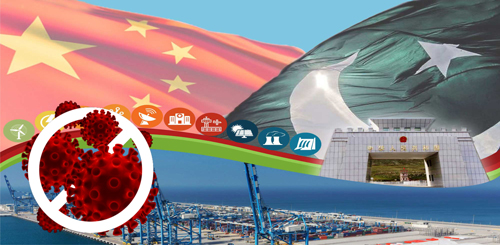S M Hali
CPEC has been progressing and contributing to Pakistan’s economic and social development even in the face of adverse circumstance due to COVID-19. The mega project brings solidarity, assistance and confidence to the people of Pakistan. To add impetus to CPEC projects, on March 16-17, President Dr. Arif Alvi paid a state visit to China. The leadership of the two countries met and agreed to further promote the development of CPEC. An MOU was signed to set up two new working groups on science, technology and agriculture, under the framework of CPEC.
On March 25, working group meeting on energy was held. The working group will continue to meet and coordinate with other working groups under the CPEC framework to make preparations for the JCC meeting. Contrary to negative speculation, China has not withdrawn engineers working on CPEC projects nor laid off Pakistani workers since the outbreak of COVID-19 in Pakistan. Currently, CPEC hosts nearly 7,000 Chinese and 40,000 Pakistani employees. Over 40,000 Pakistani families are directly supported by the CPEC projects.
Energy sector under CPEC continues to provide power. Transportation projects facilitate the transportation of medical material. The Special Economic Zones (SEZs) under CPEC depict economic vitality. Social sector under CPEC provides relief to the public. It is heartening that owing to concerted precautions for preventing COVID-19, no infection occurred at any of CPEC projects. The Chinese companies attach great importance to the protection of both Chinese and Pakistani employees. Some companies are planning to send medical teams to Pakistan to better protect the projects and the joint interests of the two peoples.
So far, China has donated 125,400 COVID-19 Real-time PCR kits, 2.8 million surgical masks, 0.42million N95 masks, 1.2 million medical gloves 0.21 million medical protection suits, 217 ventilators to Pakistan, and also provided four million USD to Pakistani government for building an emergency hospital. Chinese medical expert teams are in Pakistan to provide assistance and expertise in the fight against COVID-19. There are more in the pipeline. Chinese companies working in CPEC projects have made themselves as part of the local community and are active in lending a helping hand in different ways to Pakistan. All provinces have benefited from it.
Some examples are the All Pakistan Chinese Enterprises Association, under whose aegis, some companies have provided medical supplies and donations to Pakistan to fight COVID-19. Zonergy Company Limited of China, China Machinery Engineering Corporation (CMEC) called on Prime Minister Imran Khan in Islamabad on 8 April and donated Rs 5 million to the Prime Minister’s COVID-19 Relief Fund. They also donated medical supplies worth Rs three million to the National Disaster Management Authority (NDMA) that include 30,000 masks, 100 N95 masks and 300 protection suits. The industrial and commercial bank of China has donated medical supplies to Pakistani Embassy in Beijing. Power China Port Qasim Electric Power Company (Private) Limited (PQEPC) donated Rs.321,000 to Pakistan medical authorities for fighting the COVID-19 epidemic.
In Baluchistan, the Gwadar East-Bay Expressway Project in collaboration with China Overseas Ports Holding Company and Chinese Red Cross medical team in Gwadar has donated medical supplies to GDA Hospital. China Power Hub Generation Company (Pvt.) Ltd. (CPHGC) has donated ration bags to the deserving families in the villages of Hub. CPHGC also distributed 1000kgs of disinfectants and 2000 masks to the Office of the Assistant Commissioner Hub. In KP, China Railway Construction Corporation (International) Limited (CRCC presented epidemic prevention material including face masks, hand sanitizers to Government of Khyber-Pakhtunkhwa for combating COVID-19. China Railway (CREC) presented face masks and disinfectants to Pakistan Railways in the fight against COVID-19.
CPEC has created more than 75,000 jobs directly and 200,000 jobs indirectly for the Pakistani people, with its per capita income increased by 23 per cent. More than 100 small and medium-sized enterprises have participated in the construction of CPEC, providing hundreds of thousands of jobs. CPEC is expected to create 2.3 million jobs between 2015 and 2030 and boost Pakistan’s annual economic growth rate by 2-2.5pc, according to the Pakistani government. Amid the contribution of CPEC, Pakistan is ranked 108 in the ease of doing business from 136, according to the latest World Bank annual ratings. Under the joint planning of the two governments, the next phase of development of CPEC will continue to advance infrastructure constructions, focus on people’s livelihood and industrial and agricultural cooperation, maintain a sound momentum of high-quality development and bring more benefits to the two countries and peoples.
In the realm of energy, 12 power projects have either been completed or are under construction. The total installed capacity of these projects is 7,240 MW with total investment of about 12.4 US billion dollars. In addition, nine projects are under preparation stage, with a total installed capacity of 6390 MW. As of fiscal year 2018-19, COD CPEC energy projects had generated $250 million in tax revenue for Pakistan and provided over 10,000 jobs. They now accounted for 14.5% of available energy in the NTDC grid. Chinese and Pakistani sides agreed to expedite the design review and feasibility approval of the Main Line-I (ML-1) Peshawar-Karachi railway project. Both sides also agreed to constitute a financing committee to explore the possibility of RMB financing. Both sides agreed to consider Quetta Mass-transit and greater Peshawar Mass-transit project in the next JWG Meeting after approval of their PC-1s. Despite the black clouds of COVID-19 hovering, CPEC endeavours in the backdrop of the pandemic are providing social, industrial and economic support to Pakistan.










